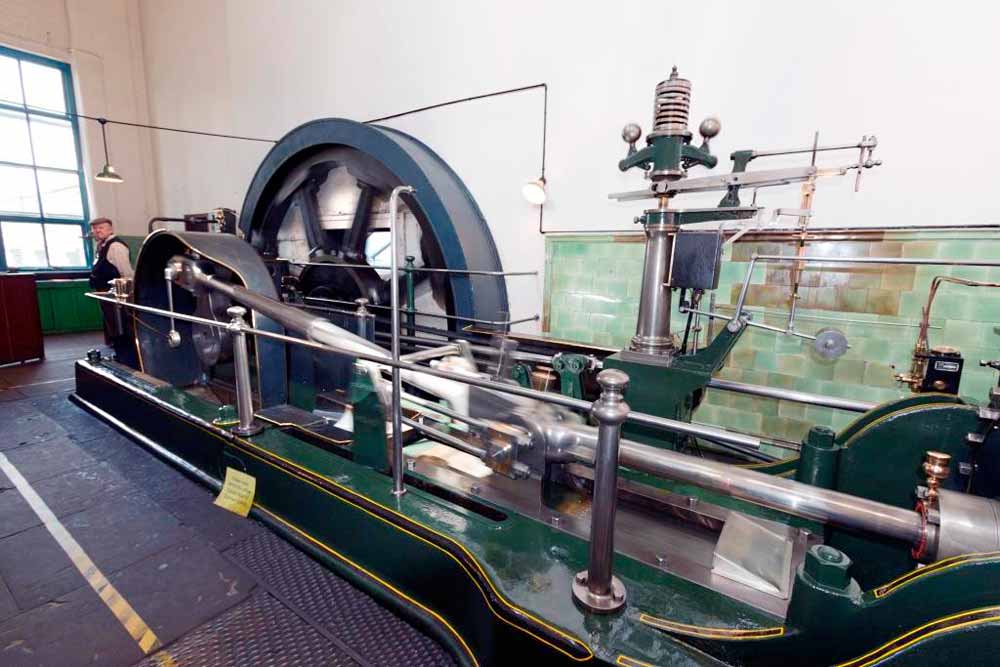
The world’s only surviving steam powered weaving mill | Queen Street Mill
by Northern Life
On the outskirts of Burnley, in the area of Harle Syke is the world’s only surviving steam powered weaving mill. The mill was set up as a worker’s co-operative in 1894 when the capital of £20,000 was raised in the form of £5 shares. It was built at a time when the 50,000 looms in Burnley boasted that they produced more length of cloth than any other town in the world. However, that was also the era when the Victorian industrial empire was beginning to collapse in the face of competition from abroad, especially from America and Germany.
All the looms used in the mill were bought from Burnley companies and they have never been replaced. The engine to power the looms, was initially called ‘Prudence’ but after a devastating fire in 1918 this name was changed to ‘Peace’ as a mark of respect for the fallen soldiers of the First World War.
- The engine to power the looms, was initially called ‘Prudence’ but after a devastating fire in 1918 this name was changed to ‘Peace’ as a mark of respect for the fallen soldiers of the First World War
In 1915 many weavers in the town went on strike because a four-loom weaver was only being paid 24s. per week which was less than other weavers. However, because the weavers in Queen Street Mill were also shareholders, many of them refused to go on strike. The Weavers’ Union produced leaflets naming the workers from the Queen Street Mill as ‘Scabs’ and ‘Knobsticks’ because they refused to join the strike.
By March 1982 there were only 440 looms still in operation and it was no longer financially viable to keep it open and Burnley Borough Council stepped in to save the mill.
Major refurbishments were then undertaken by Lancashire County Council Museums Service with help from English Heritage, the National Heritage Memorial Fund and the European Memorial Fund. Ten years later the mill was once again open for visitors with the machinery in the mill now being deemed to be a collection of national importance.
The steam engine, Peace, still powers the 308 looms that are still in use and are used to make specialist commissions. They weave the blue and white cloth used by ‘Old Town’ of Holt, Norfolk who produce Victorian work ware and the looms also weave the cloth for Jewish prayer shawls.
- Loom
- Weaving shed at Qeeen Street Mill
One of the features that visitors to the mill notice is that, not only can they see the looms in motion but there is a smell of oil and cloth and dust. However, when the looms are running, the most memorable impact of the visit is the noise. The volume of sound that just one-third of the original number of looms make when they are running is incredible. It is deafening; it is hard to even think with all the machinery clattering, the leather straps careering round and the banging of the shuttles as they race right to left and back again.
Many of the workers from the textile mills became used to this sound of weaving and could lip-read with ease, as this was the only way they could communicate with their colleagues when the looms were running.
As the world’s only surviving steam powered weaving shed, Queen Street Mill has undergone many changes in the 100 years since it was built. But few of those first shareholders of the mill, even if they could have foretold of television and film, would ever have envisaged that the mill would have been used as a backdrop for the filming by the BBC of the novel North and South by Elizabeth Gaskell. A book written 40 years before the mill was opened.
Or that Hollywood would descend on Harle Syke when the mill scenes from the multi-Oscar winning film The King’s Speech were shot on location at the Queen Street Mill. Workers at the mill took their places as extras alongside Colin Firth, playing the role of King George VI and Helena Bonham-Carter as Queen Elizabeth, the Queen Mother.
Today, visitors are more likely to see Steam-punks dressed in their regalia of bizarre black costumes, black Doc-Martins and old-fashioned motor-cycle goggles worn on the top of their heads, than Oscar-winning film stars.
However, they are able to see, and hear, the Lancashire looms; see the manually stoked boiler, and the impressive, beautifully preserved and maintained engine, Peace.
But in these days of austerity, it may be too late to save this historic working museum and the sound of weaving may already have been silenced forever.
By Barbara McHallam







